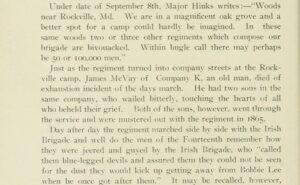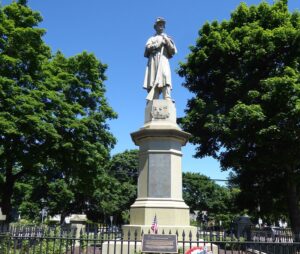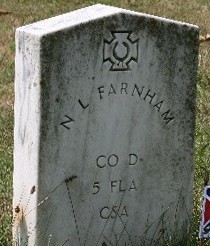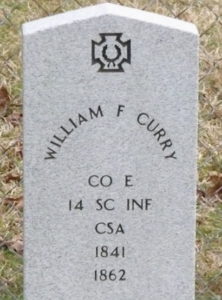This stuff will drive you nuts
7 August 2020
The Antietam Cemetery History has him as Daniel Mibbon, 18th New York Infantry (thanks Western Maryland’s Historical Library/WHILBR!). It’s Dan’l Mibbon, N.Y. on his stone.
Frederick hospital records list him as Daniel S. Milborne, 13th New York (thanks National Museum of Civil War Medicine!).
He doesn’t appear in the rosters for either of those regiments or any other New York unit, for that matter (thanks New York State Military Museum!). Nothing close.
A little more digging, though, and voilà !!
Under or near this stone in the Antietam National Cemetery lies David Spencer Milburn, late Private, Company D, 13th New Jersey Infantry. A 26 year old farmer, he was mortally wounded on 17 September 1862 just over a month after enlisting. He died in a hospital in Frederick on 2 October.
I hope his descendants can still find him!
James VcVay & Sons
4 August 2020
James McVay was an “old man” in the 14th Connecticut Infantry. He had enlisted as a Private in Company K with his sons Michael and Francis in July 1862. He died of “exhaustion” at the end of the regiment’s first day’s march on what became the Maryland Campaign.
His was the first death in that brand new regiment.
His name’s on a familiar looking monument in Norwich, CT.
___________
Notes
The clip above is from Charles D. Page’s History of the Fourteenth Regiment, Connecticut Vol. Infantry (1906).
The picture of the Soldiers’ Monument in Norwich, CT is online from Waymarking. You’ll notice the statue’s similarity to “Old Simon” in the Antietam National Cemetery.
Modern headstones
19 July 2020
I recently tweeted about adding a new bio page for a Georgia soldier, Andrew W Poarch and, somewhat as an aside, noted that his modern headstone has some problems.
He was buried at Mt. Olivet Cemetery in Frederick, MD in October 1862 and at some point given a basic headstone, now heavily worn.
Much more recently, sometime after 1992, well-meaning persons got him and each of the other Confederate soldiers buried in Mt. Olivet a new headstone from the US Department of Veterans Affairs (VA).
Probably because of transcription errors in his original burial records, they got his name terribly wrong. Apparently the applicant for the new headstone didn’t dig any deeper – into the soldier’s service records, muster rolls, or family genealogies, for example – to verify his information. Although, to be fair, it’s easier to do that today than it was 20 or 30 years ago.
But now the errors are literally carved in stone.
I’ve seen dozens of markers like these with errors large and small over the years of researching my soldiers, but had not thought to make a list or keep a log of them.
The day after Private Poarch’s, though, I found another such case – the stone for Louisianan Volney L. Farnham at Elmwood in Shepherdstown, WV. It has his first initial/name and his regiment wrong.
And this afternoon a third popped-up: Private William T. Curry of South Carolina. This is his modern VA marker in Dials Cemetery, Gray Court, SC. Minor things, to be sure, but his middle initial and his year of birth are probably wrong.
So taking these 3 stones as huge cosmic hints, I’m starting a visual list here, and I’ll add to it as I find more. I can’t fix them, but I can provide a virtual erratum.
Let me know if you find any more cases like these, won’t you? Or if you have any information that corrects errors I’ve made.
_____________
Gravestone pictures via Findagrave.
_____________
[50] additions after the break …







